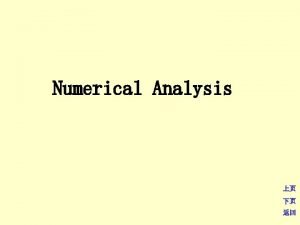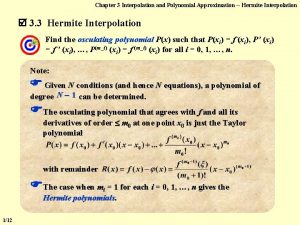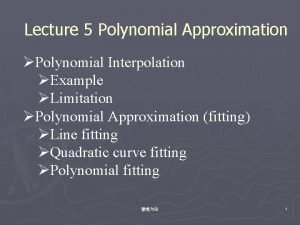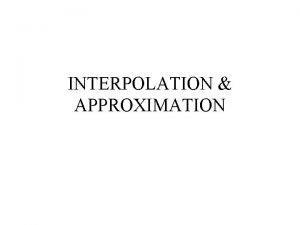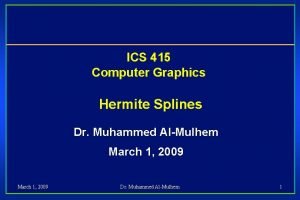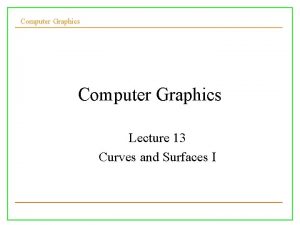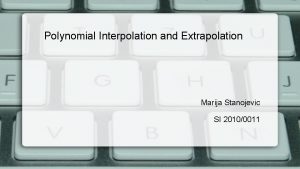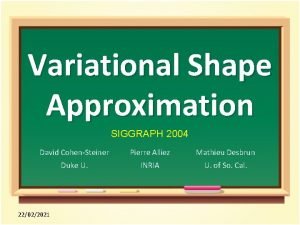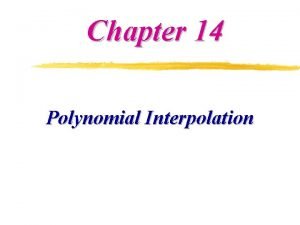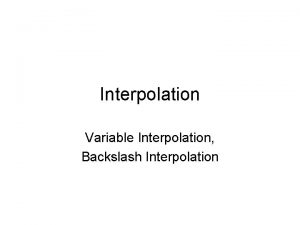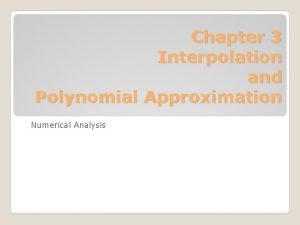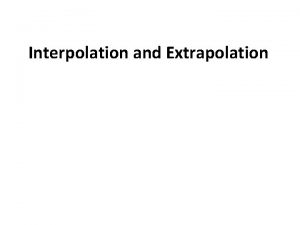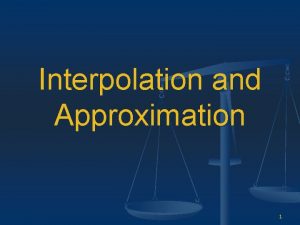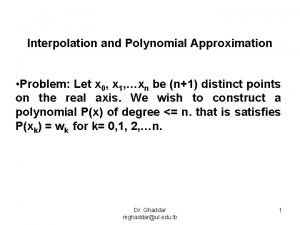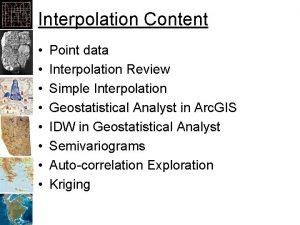Chapter 3 Interpolation and Polynomial Approximation Hermite Interpolation












- Slides: 12

Chapter 3 Interpolation and Polynomial Approximation -- Hermite Interpolation 3. 3 Hermite Interpolation Find the osculating polynomial P(x) such that P(xi) = f (xi), P’ (xi) = f ’ (xi), …, P(m_i) (xi) = f (m_i) (xi) for all i = 0, 1, …, n. Note: Given N conditions (and hence N equations), a polynomial of degree N 1 can be determined. The osculating polynomial that agrees with f and all its derivatives of order m 0 at one point x 0 is just the Taylor polynomial with remainder The case when mi = 1 for each i = 0, 1, …, n gives the Hermite polynomials. 1/12

Chapter 3 Interpolation and Polynomial Approximation -- Hermite Interpolation Example: Suppose x 0 x 1 x 2. Given f(x 0), f(x 1), f(x 2) and f ’(x 1), find the polynomial P(x) such that P(xi) = f (xi),i = 0, 1, 2, and P’(x 1) = f ’(x 1). Analyze the errors. 3. Solution: First of all, the degree of P(x) must be … Similar to Lagrange polynomials, we may assume the form of Hermite polynomial as 2 P 3 ( x ) = f ( x i ) hi ( x ) + f ’� ( x 1 ) h 1 ( x ) Similar to i = 0 Lagrange error analysis where hi(xj) = ij , hi’(x 1) = 0, h 1 (xi) = 0, h 1’(x 1) = 1 h 0(x) Has roots x 1, x 2, and h 0’(x 1) = 0 x 1 is a multiple root. h 0 ( x ) = C 0 ( x x 1 )2 ( x x 2 ) h 0(x 0) = 1 C 0 h 2(x) Similar to h 0(x). = + h 1(x) Has roots x 0, x 2 h 1 ( x ) ( Ax B )( x x 0 )( x x 2 ) A and B can be solved with h 1(x 1) = 1 and h 1’(x 1) = 0. Has roots x , x h 0 1 2 1( x ) = C 1 ( x x 0 )( x x 1 )( x x 2 ) h 1(x) ) = 1 C 1 can be solved. h’(x 1 1 2/12

Chapter 3 Interpolation and Polynomial Approximation -- Hermite Interpolation In general, given x 0 , …, xn; y 0 , …, yn and y 0’ , …, yn’. The Hermite polynomial H 2 n+1(x) satisfies H 2 n+1(xi) = yi and H’ 2 n+1(xi) = yi’ for all i. Solution: Let H 2 n+1( x ) = n i =0 yi hi ( x ) + n i =0 yi’ h i ( x ) )= where hi(xj) = ij, hi’(xj) = 0, hi (xj) = 0, h’(x ij i j hi(x) x 0 , …, xi , …, xn are all roots with multiplicity 2 hi ( x ) = ( Ai x + Bi )Ln, 2 i ( x ) Ai and Bi can be solved by hi(xi) = 1 and hi’(xi) = 0 Such a Hermite interpolating polynomial is unique hi (x) All the roots x 0 , …, xn have multiplicity 2 except xi hi( x) = Ci ( x xi ) Ln, i 2(x) hi(x) = ( x xi ) Ln, i 2(x) h’(x i i) = 1 Ci = 1 If 3/12 , then

Chapter 3 Interpolation and Polynomial Approximation -- Hermite Interpolation Quiz: Given xi = i +1, i = 0, 1, 2, 3, 4, 5. Which one is h 2(x)? y y 1 - 1 - slope=1 0. 5 - 0 1 2 3 4 5 6 x HW: p. 140 #7 4/12 2 3 4 5 6 x

Chapter 3 Interpolation and Polynomial Approximation -- Cubic Spline Interpolation 3. 4 Cubic Spline Interpolation Example: Consider the Lagrange polynomial Pn(x) of on [ 5, 5]. Take 2. 5 Remember what I have said? Pn(x) f (x) Increasing the degree of interpolating polynomial will NOT guarantee a good result, since high-degree polynomials are oscillating. 2 1. 5 1 Piecewise polynomial approximation 0. 5 0 -0. 5 -5 5/12 -4 -3 -2 -1 0 1 2 3 4 5

Chapter 3 Interpolation and Polynomial Approximation -- Cubic Spline Interpolation Piecewise linear interpolation Approximate f (x) by linear polynomials on each subinterval Let . Then uniform as No longer smooth. How can we make a smooth Hermite piecewise polynomials interpolation without asking Given too much from f ? Construct the Hermite polynomial degree 3 with y and y’ on the Headacheof… two endpoints of . It is not easy to obtain the derivatives. 6/12 :

Chapter 3 Interpolation and Polynomial Approximation -- Cubic Spline Interpolation Cubic Spline Definition: Given a function f defined on [a, b] and a set of nodes a = x 0 < x 1 < … < xn = b, a cubic spline interpolant S for f is a function that satisfies the following conditions: a. S(x) is a cubic polynomial, denoted Si(x), on the subinterval [ xi , xi+1] for each i = 0, 1, …, n – 1; b. S(xi) = f (xi) for each i = 0, 1, …, n; c. Si+1(xi+1) = Si(xi+1) for each i = 0, 1, …, n – 2; d. S’i+1(xi+1) = S’i(xi+1) for each i = 0, 1, …, n – 2; e. S”i+1(xi+1) = S”i(xi+1) for each i = 0, 1, …, n – 2; f(x) H(x) S(x) 7/12

Chapter 3 Interpolation and Polynomial Approximation -- Cubic Spline Interpolation Method of Bending Moment Let hj = xj – 1 and S(x) = Sj(x) for x [ xj – 1, xj ]. The bending moment Then Sj”(x) is a polynomial of degree 1 , which can be determined by the values of f on 2 nodes. 1. Assume Sj”(xj 1) = Mj 1, Sj”(xj) = Mj. Then for all x [ xj – 1, xj ], For each j it is a cubic polynomial xj x x x j 1 Sj”(x) = M j 1 h + M j h j j Integrate Sj”(x) twice, we obtain Sj’(x) and Sj (x) : Sj’(x) = ( x j x )2 ( x x j 1 ) 2 M j 1 + Aj 2 h j ( x j x) ( x x j 1 ) + Mj + Aj x + B j Sj(x) = M j 1 6 hj 3 8/12 3 Can be solved by Sj(xj 1) = yj 1 Sj(xj) = yj

Chapter 3 Interpolation and Polynomial Approximation -- Cubic Spline Interpolation yj 1 Mj 1 = Aj hj hj 6 M j 1 2 x j x M j 2 x x j 1 + ( yj Aj x + Bj = ( y j 1 hj ) h) 6 hj 6 j hj Now solve for Mj : Since S’ is continuous at xj ( xj x)2 ( x xj 1 )2 Mj 1 + Mj + f [ xj 1 , xj ] hj [xj 1, xj ]: Sj’(x) = Mj 1 2 hj 6 2 2 ( x j+1 x) ( x xj ) Mj+1 Mj + Mj+1 + f [ xj , xj+1 ] hj+1 [xj , xj+1]: Sj+1’(x) = Mj 2 hj+1 6 From Sj’(xj) = Sj+1’(xj), we can combine the coefficients for Mj 1, Mj, and Mj+1. 6 h j +1 = g ( f [ x j , x j +1 ] - f [ x j -1 , x j ]) Define j = , j = 1 - j , and j hj +1 h j +1 j M j -1 + 2 M j + j M j + 1 = g j for 1 j n 1 That is, we have n+1 unknowns but only n 1 equations. Extra 2 boundary conditions are needed. 9/12

Chapter 3 Interpolation and Polynomial Approximation -- Cubic Spline Interpolation S’(a) = y 0’, S’(b) = yn’ /* Clamped boundary */ 2 M M 0 ( x 1 x) ( x a)2 + M 1 + f [ x 0 , x 1 ] 1 [ a , x 1 ]: S 1’(x) = M 0 h 1 2 h 1 6 2 M 0 + M 1 = 6 ( f [ x 0 , x 1 ] y 0 ’ ) = g 0 Similar for Sn’(x) on [ h 1 xn 1, b ] M n 1 + 2 M n = 6 ( yn’ f [ x n 1 , x n ]) = g n hn S”(a) = y 0” = M 0, S”(b) = yn” = Mn The case when M 0 = Mn = 0 is called a free boundary, and when that occurs, the spline is called a Natural Spline. Periodic boundary: If f is a periodic function, that is, yn = y 0 and S’(a+) = S’(b ) M 0 = Mn 10/12

Chapter 3 Interpolation and Polynomial Approximation -- Cubic Spline Interpolation Note: Cubic Spline can be uniquely determined by its boundary conditions as long as the coefficient matrix is strictly diagonally dominant. If f C[ a, b ] and . Then as max hi 0. That is, the accuracy of approximation can be improved by adding more nodes without increasing the degree of the splines. HW: p. 153 -154 #9, 17 Sketch of the Algorithm: Cubic Spline ② Solve for M ; Compute j , gj ; j ③ Find the subinterval which contains x (i. e. find the corresponding j ); ④ Approximate f(x) by S (x). j ① 11/12

Chapter 3 Interpolation and Polynomial Approximation -- Cubic Spline Interpolation Lab 06. Cubic Spline Time Limit: 1 second; Points: 4 Construct the cubic spline interpolant S for the function f, defined at points x 0 < x 1 < … < xn, satisfying some given boundary conditions. Partition an given interval into m equallength subintervals, and approximate the function values at the endpoints of these subintervals. 12/12
 Interpolation in numerical methods
Interpolation in numerical methods Cubic hermite interpolation
Cubic hermite interpolation Spline interpolation vs polynomial interpolation
Spline interpolation vs polynomial interpolation Interpolation vs approximation
Interpolation vs approximation Fully polynomial time approximation scheme
Fully polynomial time approximation scheme Hermite curve in computer graphics
Hermite curve in computer graphics Computer
Computer Hermite曲线
Hermite曲线 Neville interpolation
Neville interpolation Polynomial interpolation
Polynomial interpolation Numpy.polynomial.polynomial
Numpy.polynomial.polynomial How to divide a polynomial by another polynomial
How to divide a polynomial by another polynomial Variational shape approximation
Variational shape approximation
